Extreme Weather, Degradation Impact US Solar Projects in a Small But Significant Way – Mercom India
Climate change-induced extreme weather events like hail, flooding, and high winds are accelerating solar module damage above certain thresholds, causing greater long-term losses in system performance, according to researchers from the National Renewable Energy Laboratory (NREL).
Researchers compared photovoltaic (PV) system performance against the National Oceanic and Atmospheric Administration’s weather maps and studied how performance was affected when extreme events occurred within 10 kilometers of the systems.
They found that flooding and hail caused most short-term solar outages, where the median outage length after an extreme weather event was two to four days, resulting in a 1% median loss in annual performance.
However, above certain levels, such as hail over an inch in diameter, winds over 90 kilometers per hour, and snow depths greater than 1 meter, the system had greater annual performance losses. This was due to mechanical stress, which can lead to cracked cells within PV modules.
Overall, however, the analysis of thousands of PV solar power systems across the U.S. has found that solar modules are degrading at expected rates, losing about 0.75% of performance per year, which confirms previous studies.
“It shows that our fleet of PV systems, on the whole, is not failing catastrophically, but rather degrading at a modest rate within expectations,” said Chris Deline, group manager for PV field performance at NREL, stressing the importance of accurately quantifying the rate of degradation as it is used in financing agreements that fund solar projects.
The analysis, compiled from over 25,000 solar inverters across 2,500 commercial and utility solar sites in 37 states and U.S. territories, also revealed that performance in hotter regions like the Southwest degrades nearly twice as fast as cooler climates. Degradation in hotter climates was 0.88% per year compared to 0.48% per year in cooler climates.
Countering Extreme Weather Impact
Accurate solar module testing standards, manufacturing quality, and weather-resilient mounting and installation practices are key to minimizing power loss, the researchers said. Data sharing and analysis can also help the solar industry proactively identify issues and improve real-world solar system lifetimes and performance.
With solar panel warranties spanning 25 years and project financiers planning on decades of power production, small differences in sustained energy output are crucial for maintaining system economics. The small differences can even determine if a system operates at a profit or a loss.
Additionally, the researchers also warned the industry that recent trends, such as larger modules, thinner cells, and thinner front glass, may increase system vulnerability if not designed and tested appropriately.
In January, an International Energy Agency report said the soiling of solar PV systems from dust and snow could lead to a 4-5% loss in energy production worldwide.


